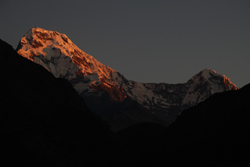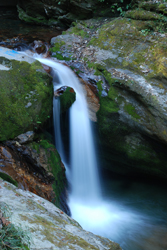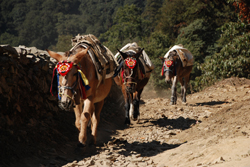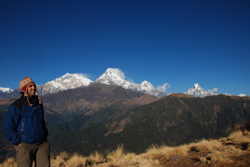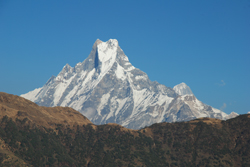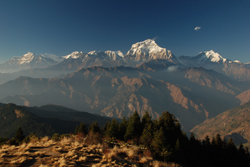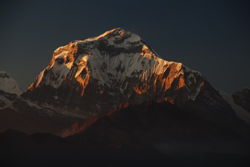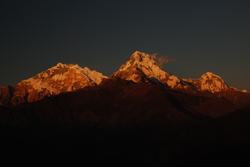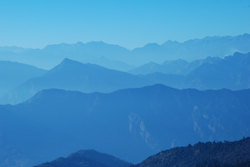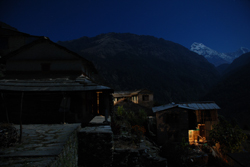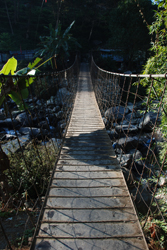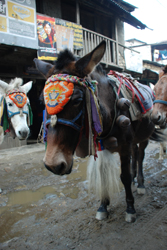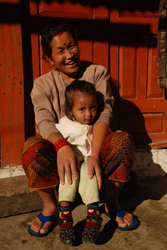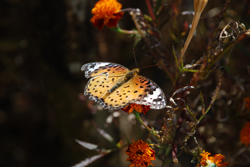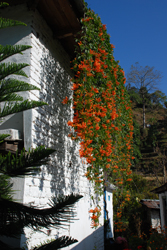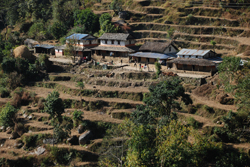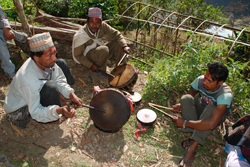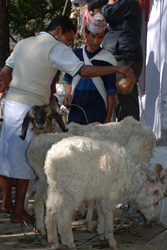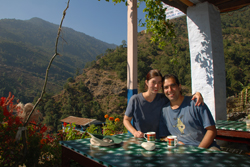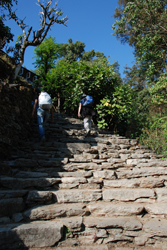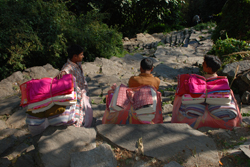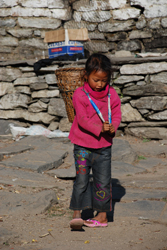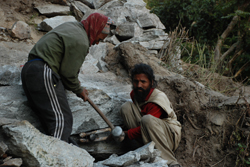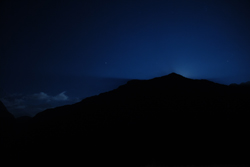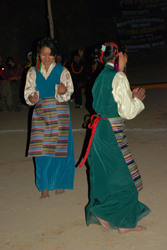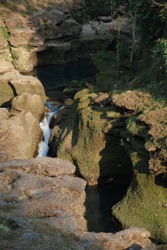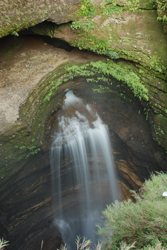Ghorepani Trek Day 2: Prime Seats for a Mountain View
13 December, 2008, 01:58 am in "Nepal"
Dipak said we could sleep in since it is just a 3-4 hour walk today from Ulleri to Ghorepani. However, how can you sleep in when you know there is a spectacular mountain outside your window waiting for the rising sun to touch its slopes and wake up the colors hidden by night.
It was light when I woke up but the sun hadn't made it above the mountains. The sky was a rich shade of blue. Looking from under the warmth of my blanket, Annapurna South looked like it had been coated with marshmallow fluff which shined in the faint light. Rowshan jumped up and went running outside as the first light touched the tip of the mountain with rose. Quickly the color of the snow was transformed from pink to light gold to white of day. To the East the lower mountains were shadows in a golden haze.
It was light when I woke up but the sun hadn't made it above the mountains. The sky was a rich shade of blue. Looking from under the warmth of my blanket, Annapurna South looked like it had been coated with marshmallow fluff which shined in the faint light. Rowshan jumped up and went running outside as the first light touched the tip of the mountain with rose. Quickly the color of the snow was transformed from pink to light gold to white of day. To the East the lower mountains were shadows in a golden haze.
We left Ulleri and went up more stairs. The trail rose and descended. Villages became sparser. We were walking through a cool, damp cloud forest. On our right, a secretive river cut overhangs into the rocks where tendrils of ferns and vines hung like insect appendages. The trees wore a coat of green fur moss. The water fluctuated between teal and rust depending on the plant life.
Earlier we had tried to overtake a mule train to avoid having to walk following a trail of fresh pungent mule manure. The mules, however, were too fast and after exhausting ourselves we never succeeded even of getting clear of their clanging bells (which bore a striking resemblance in sound to the evil bunny in that old puppet animation “Peter Cottontail” Easter special.) They passed us later on their return trip.
The first part of Ghorepani was lower. We we went through it and up until we got to the main part of the town which perches on the mountain side, occupying a prime seat in an arena of mountains. First we saw just one mountain. Then, walking a bit further the buildings opened up revealing the entire vista from the Dhaulagiri range to the Annapurnas: massive gray rocks with streaks and stretches of snow, shining clean and white against the deep blue sky.
After a lunch of dhal bhat, Rowshan raced up to Poon Hill, the location from which many postcards and posters of the Himalayas are taken. We had all talked about going up for the sunset but that was still 4 hours away.
After a lunch of dhal bhat, Rowshan raced up to Poon Hill, the location from which many postcards and posters of the Himalayas are taken. We had all talked about going up for the sunset but that was still 4 hours away.
It is hard to believe that the view can get better than Ghorepani (2800 meters) but as we got higher, the tops of more mountains appeared over the hills. Machhapuchre's “Fish Tail” looks more and more fishy as you get closer.
The crest of Poon Hill (3,200 meters), with a white viewing tower, golden grass, and blue sky was reminiscent of a beach scene for some reason-- or rather the dry beach grasses and lifeguard's tower on the last hill before you descended to the ocean and sandy beach.
The illusion was smashed as soon as I climbed a little higher and saw, instead of an expanse of the sea, and expanse of sky and a semi-circle of mountain peaks-- disappearing into he distance. Nagarkot and Chisopani were beautiful but standing on Poon Hill is like being suspended from the sky among some of the largest mountains in the world. I am used to being faced with one or max 2 stunning peaks at a time: Mt Rainier, Mt. Hood, Mouna Kea. But here, every peak is a behemoth-- larger than life, not a fragile pinnacle but a vast island of rock covered with snow rising from a sea of mountains that you want to call hills because they are so dwarfed by the mountains.
The illusion was smashed as soon as I climbed a little higher and saw, instead of an expanse of the sea, and expanse of sky and a semi-circle of mountain peaks-- disappearing into he distance. Nagarkot and Chisopani were beautiful but standing on Poon Hill is like being suspended from the sky among some of the largest mountains in the world. I am used to being faced with one or max 2 stunning peaks at a time: Mt Rainier, Mt. Hood, Mouna Kea. But here, every peak is a behemoth-- larger than life, not a fragile pinnacle but a vast island of rock covered with snow rising from a sea of mountains that you want to call hills because they are so dwarfed by the mountains.
The light was perfect on the Annapurnas. To the south, the hills were turning into violet shadows. To the West, the sun was changing the hills there into orange and gold shadows. Shadows emphasized the perfect clarity of the Annapurnas.
We watched the transformation of color. The sun's blazing fire disappeared behind a hill. We tried to leave but were left transfixed by the rose color that spread over the top of the mountains and how the lower areas of snow turned a glacial blue. The pink of the sky and the purples and blues of the mountains made me think of dreams, as if the whole world was put to sleep and dreamed shapes of mountains in violets, lavenders and blues.
Ghorepani Trek Day 1: Stairway to Ulleri
12 December, 2008, 02:35 am in "Nepal"
Our trek started with a nausea inducing taxi ride over a smaller mountain to Nayapul. Once we got out of Pokhara, the air cleared and the iconic peak of Machhapuchre glistened against the morning sky. We drove along the Seti River, then up and down a winding road to Nayapul. Nayapul occupies a patch of land between road, mountainside, and the Modi river which has its source near the Annapurna Basecamp. Nayapul is named for the “New Bridge” (Naya Pul), a suspension bridge across the river. The village street had a bunch of mules with colored decorations and strings of bells that jingled as they trembled. The road went towards Machhapuchre “Fish Tail” which showed its fish tail peek from the angle.
The entrance to the Annapurna Conservation Area was the village of Birethanti which was a pretty collection of lodges and restaurants set in the hill above the river. The women in the area wear pretty wrap skirts made in a combination of earth tones and rich colors.
As we walked up the path, which was a neat flagstone road, we passed bright white washed stone houses with blue trim. Orange honeysuckle flowers hung from vines like the marigold garlands hung on shrines.
At one shrine we heard the sound of drumming. A crowd was gathered. Close to the shrine were a group of men, each leading a sheep. Dipak, our guide, said it was an annual festival where the ancestors are honored through each family sacrificing a sheep or goat. He explained the holy day was only celebrated by the Gurung people of this region.
The last stretch of the trail consisted of more than 3500 stairs. Sometimes we stopped to admire the view of Annapurna South. Annapurna means “food enough”. The range got the name because people thought it looked like an overflowing dish/pile of rice. As we were going up the stairs, we passed porters, carrying huge loads of mattresses and fabrics. They would visit the various villages then go down and bring another load.
At another point on the stairs, we saw men working on fitting rocks into a wall to support the area around other stairs. Dipak said they'd been working on it for a month. One Month ago there was a huge boulder which threatened safety since it could come loose and roll. So the workers lit a bonfire under it then poured cold water over it until the rock cracked. Then they broke the pieces further and made the wall.
Finally we reached Ulleri which is a small village with its share of hotels but also some buildings that may be normal people's homes. The climb, of course, was worth it since Ulleri commands a view, between tree covered mountains, of the huge mass of Annapurna South. As we arrived it looked like clouds would cover it by the time sun set. But the clouds seem to have sunk and gathered on the bottom.
In the evening we ventured away from the fire to go to a cultural presentation the town was putting on. When we walked in, garlands of orange marigolds were draped over our heads. Different young people danced: women danced barefoot although everyone else was bundled up.
Devis Falls and Unwelcome Chitwan Souvenirs
11 December, 2008, 02:35 am in "Nepal"
The walk to Devi's Falls took us along the lake, by the dam, and then along a busy road where minibuses and motorcycles rushed by. We got tailed by a couple kids begging for “one rupee”. Eventually they gave up on us as we reached the entrance to Devi's Falls.
The site didn't look like the location of a water fall. In fact, looking through the gate, it was kind of flat and grassy with a concrete model of the Himalayas. A concrete walkway descended maybe 10 feet and led to where the falls were. From the path we could see large rocks carved by the water into mismatched puzzle pieces. The carved stones created windows where we could see glimpses of rushing water. One of the walkways brought us to the edge where the falls were visible, bursting through one of the stone windows and plummeting into the dark chasm. We couldn't see the bottom but this was partly due to the walkway being set a little back from the edge. There was less water than in the summer but the falls were impressive just because of their subterranean nature. The stone walls of the chasm were covered with green plants which hung like stalactites. Another walkway led up a little to the top of the falls where water gathered in dangerous dark calm pools before it hurled over the edge.
A sign provided the following information about the falls. The ancient name was Patale Chhango. However, the falls began to be called Devis Falls in 1961. The charming story of the name change (as described on the sign) is as follows:
“On 31st July 1961 A.D. In the afternoon a sudden flood from Phewa Lake swept away a Swiss citizen Mrs. Devis who was having a bath with her husband beside it. She was flowed and dead. She was recovered after a long attempt. Since then, it has been taken its name “Devis Falls.”
I'm not sure what it means to be “flowed”, either.
In the evening both of us had the unpleasant surprise of finding ticks. After Rowshan bravely removed them from me and himself, he washed everything with boiling water heated up in our little electric water boiler since the hotel hot water was solar and only worked when it was sunny. The process took hours.
The hotel manager said that lots of people return from jungle safaris with these unpleasant hitchhikers. He said they didn't carry any particularly frightening diseases like other ticks in the world.... a fact which I looked up on the Internet anyway.
“On 31st July 1961 A.D. In the afternoon a sudden flood from Phewa Lake swept away a Swiss citizen Mrs. Devis who was having a bath with her husband beside it. She was flowed and dead. She was recovered after a long attempt. Since then, it has been taken its name “Devis Falls.”
I'm not sure what it means to be “flowed”, either.
In the evening both of us had the unpleasant surprise of finding ticks. After Rowshan bravely removed them from me and himself, he washed everything with boiling water heated up in our little electric water boiler since the hotel hot water was solar and only worked when it was sunny. The process took hours.
The hotel manager said that lots of people return from jungle safaris with these unpleasant hitchhikers. He said they didn't carry any particularly frightening diseases like other ticks in the world.... a fact which I looked up on the Internet anyway.
Powered by My Blog 1.69. Copyright 2003-2006 FuzzyMonkey.net.
Created by the scripting wizards at FuzzyMonkey.net..
(Code modified by Rowshan Dowlatabadi)
Created by the scripting wizards at FuzzyMonkey.net..
(Code modified by Rowshan Dowlatabadi)



